Bleeding Trees: 1979
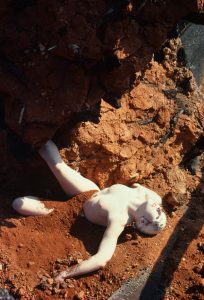
Bleeding Trees, 1979
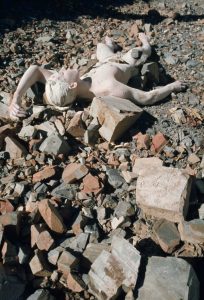
Bleeding Trees, 1979
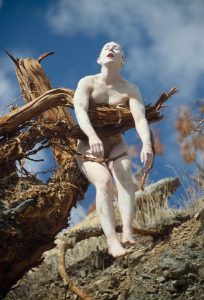
Bleeding Trees, 1979
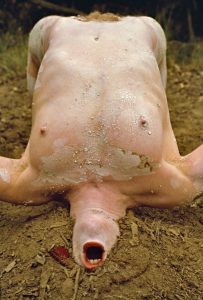
Bleeding Trees, 1979
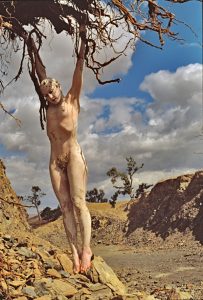
Bleeding Trees, 1979
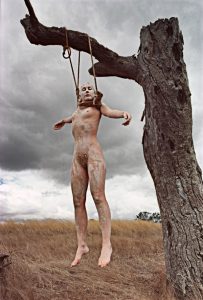
Bleeding Trees, 1979
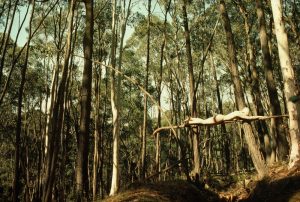
Bleeding Trees, 1979
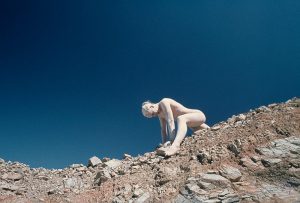
Bleeding Trees, 1979
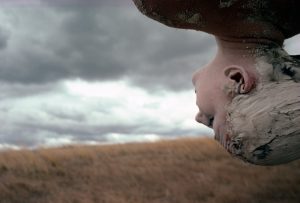
Bleeding Trees, 1979
Jill Orr
This work consists of twenty-one images that were photographed in various Victorian landscapes that projected within the live performance. The images are the representational art work. The original is shot on 35mm slide film. Bleeding Trees is an early environmental work where the body is used as an ’emotional barometer’ placed in empathy with the natural and unnatural life cycles of trees. The empathy enlisted through the viewer is through identification with the human body. As female, the early feminist critique places the naked body as ‘pandering to the male gaze’. In an environmental sense it is a gaze towards all.
There has been much written about this work that has kept it active within the collective imaginary where the reading as both feminist, environmental and in some instances religious are issues that have active currency now although grounded in the late `70`s. The live performance for the 1979 Third Sydney Biennale, European Dialogue, Gallery of New South Wales and the Paris Biennale, 1980, Musee D`Art Modern. The Bleeding Trees photographic series was exhibited in London at the Institute of Contemporary Art, in Eureka, Artists from Australia 1882, curated by Leon Parisien and Burnese Murphy Bleeding Trees, Pain Melts and Lunch with the Birds photographs have toured within Australia in 1980 and 1989& 91 Namely: Experimental Art Foundation, Adelaide Institute of Modern Art, Brisbane Canberra Contemporary Art Space Australian Centre for Contemporary Art, Melbourne Geelong Art Gallery Bendigo Art Gallery Mildura Arts Centre.
Bleeding Trees publishing details: Anne Marsh has referenced the work in her recent book The Darkroom: Photography and the Theatre of Desire, Macmillan, Melbourne 2003; Anne Marsh Body and Self: Performance Art in Australia 1969 – 92, Oxford University Press, Melbourne, 1993; Anne Marsh, catalogue essay Jill Orr, Performance Documentation 1978- 1988, The ‘I’ in the Gaze, The Australian Centre for Contemporary Art, 1989; Anne Marsh, Performing histories and the myth of Place: A Female Menace in paradoxa: international feminist art journal Volume 3 1999, p 6 – 9; Jane Magon, Spirituality in Contemporary Australian Art: Some Contexts and Issues in interpretation, Artlink Volume 18, No 1 March 1998, p38-42; Sandy Kirby, Sightlines: Women’s Art and feminist Perspectives in Australia Craftsman House, Gordon & Breach, NSW Australia 1992; Jane Magon, Religion, Literature and Art, Australian International Conference, 1994; ed. Michael Griffith and Ross Keating Lou Chamberlain, Art in Sight, McGraw Hill Book Co. 1996; National Gallery of Victoria, Federation Square opening exhibition catalogue, Fieldwork, curated by Jason Smith and Charles Green Australian Art in the National Gallery of Australia, edited by Anne Gray, produced by the publications department of the National Gallery of Australia, 2003; Ben Crawford, Art Attack, Black & White, Number 6 Australia 1994 p54-57; Art Monthly, November 1998 No. 115. Front cover image (mouth) Bleeding Trees performed during the Third Biennale of Sydney, Art Gallery of New South Wales, 1979; Photograph Elizabeth Campbell.p3. The editors, Ashley Crawford, Richard Craig, Terence Hogan, Ray Edgar, John Jost and Tom Quirk. The 1980`s: from the Leantime to the Dreamtime, Tension No. 19 Special Edition; A chronicle of Australian Art 1980 – 1989.
My performances are conceived through strong imagined images that I make manifest either for the camera directly or through a live event. I always try to do a separate shoot in the live context to maximize my direction and enable the photographers concentrated space. When all is said and done the final act is collaborative, not unlike a film and theatre director. The photographic and video documentation is the artwork. This is where I believe I differ from most other performance artists who have not necessarily worked with images in mind as the final art work. Their concentration is often in the conceptual nature of the action. My work covers both.
Performance for the camera, 1979
Photographer: Elizabeth Campbell
Created, directed and performed by Jill Orr
